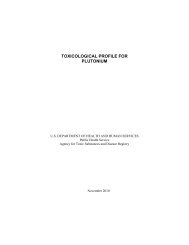BMC Evolutionary Biology
BMC Evolutionary Biology
BMC Evolutionary Biology
Create successful ePaper yourself
Turn your PDF publications into a flip-book with our unique Google optimized e-Paper software.
Alignment for protein-coding sequences was relatively straightforward. We converted them<br />
to amino acids, and then used the translation alignment algorithm in the program Geneious<br />
v4.8.4 (GeneMatters Corp.), with the default cost matrix (Blosum62) and gap penalties<br />
(open=12, extension=3). Alignments were relatively unambiguous after being trimmed for<br />
quality and maximum coverage (i.e. ambiguous end regions were removed, and most<br />
sequences began and ended at the same point).<br />
For the ribosomal RNA sequences (12S and 16S sequences), alignment was more<br />
challenging. Preliminary global alignments using the algorithms MUSCLE [207] and<br />
CLUSTAL [208] under a variety of gap-cost parameters yielded low-quality results (i.e.<br />
alignments with large numbers of gaps and little overlap of potentially homologous<br />
characters). We subsequently employed a two-step strategy for these data. We first grouped<br />
sequences by higher taxa (i.e. Amphisbaenia, Anguimorpha, Gekkota, Iguania,<br />
Scincomorpha, and Serpentes, though these are not all monophyletic as previously defined),<br />
for which alignments were relatively straightforward under the default MUSCLE parameters.<br />
These were then combined using the profile alignment feature of MUSCLE, and the global<br />
alignment was subsequently updated using the "refine alignment" option. Minor adjustments<br />
were then made by eye, and ambiguously aligned end-regions were trimmed for maximum<br />
coverage and quality. We did not include partitions for stems and loops for the ribosomal<br />
sequences, although this has been shown to improve model fit in previous squamate studies<br />
(e.g. [82]). Although it is possible to assign individual nucleotide positions to these partitions,<br />
this would have been challenging given the large number of sequences, and the potential for<br />
stems and loops to shift across the many species and large time scales involved.<br />
Each species was represented by a single terminal taxon in the matrix. In many cases,<br />
sequences from multiple individuals of the same species were combined, to allow us to<br />
combine data from different genes for the same species. We acknowledge the possibility that<br />
in some cases this approach may cause us to combine genes from different species in the<br />
same terminal taxon (e.g. due to changing taxonomy or incorrect identifications).<br />
Additionally, many sequences are not from vouchered specimens, and it is possible that<br />
misidentified species are present on GenBank and in our matrix. However, most of our data<br />
came from lower-level phylogenetic studies, in which the identification of species by<br />
previous authors should be highly accurate. In addition, any such mistakes should be among<br />
closely related species, and lead to minimal phylogenetic distortion, as the grossest errors are<br />
easily identified.<br />
Some species were removed after preliminary analyses, due either to obvious sequencing<br />
errors (e.g. high BLAST homology with unrelated families or non-squamates, excessive<br />
ambiguities) or a lack of overlap in genes sampled with other members of the same genus<br />
(leading to seemingly artificial paraphyly). We also excluded species with identical<br />
sequences between taxa across all genes, arbitrarily choosing the first taxon in alphabetical<br />
order to remain in the matrix. Additionally, we also removed a few apparent "rogue taxa"<br />
[75,77]. These were identified by their poor support and suspect placement (e.g. in a clearly<br />
incorrect family), and were typically represented in the matrix by short fragments of single<br />
genes (e.g. an ND4 fragment from the enigmatic colubroid snake Oreocalamus hanitchsi).<br />
The final combined matrix contained sequence data for: 2335 species for 12S (including 56%<br />
of all 4162 taxa, 1395 bp), 2377 for 16S (57%, 1970 bp), 730 for BDNF (18%, 714 bp), 1671<br />
for c-mos (40%, 903 bp), 1985 for cyt-b (48%, 1000 bp), 437 for NT3 (10%, 675 bp), 1860



